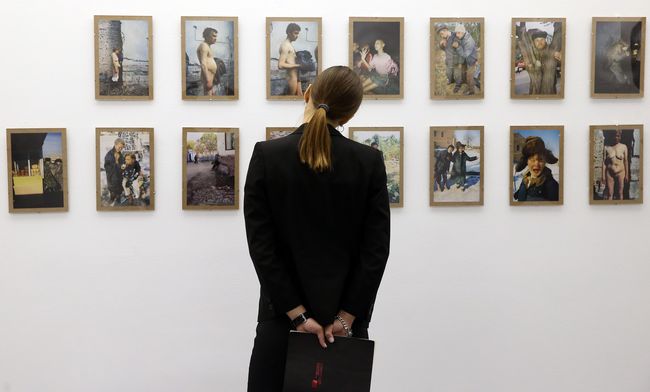Trial by freedom
PinchukArtCentre hosts “Borderline” – an exhibition of Ukrainian art of the past 30 years
In its form, the exhibition is not a Centre’s usual review of contemporary art, but a retrospective – “Borderline” focuses on the development of modern Ukrainian art from the mid-1980s to 2004 (although there is a later artwork here and there: from 2009, and even 2014).
The exhibition consists of more than 40 works of Ukrainian artists whose artistic practices were formed at the time of the USSR collapse and in the early years of independence. There are videos, paintings, and many pictures. The list of authors is impressive: Serhii Bratkov, Leonid Voitsekhov, Oleh Holosii, Yurii Leiderman, Pavlo Makov, Borys Mykhailov, Vlada Ralko, Oleksandr Roitburd, Yurii Rupin, Arsen Savadov, Heorhii Senchenko, Andrii Sahaidakovsky, Oleh Tistol, Masoch Fund, Vasyl Tsaholov, Illia Chychkan, Oksana Chepelyk. Most of these authors had regularly participated in all more or less notable vernissages in Ukraine and had been in the spotlight of the media in the past quarter century. But I want to mention just three of them.
Borys Mykhailov (a Kharkiv-born artist who lives mostly in Berlin) has his famous “Medical History” (1997-98) exhibited. This is a series of homeless people portraits – a talented and powerful attack on the canons of beauty imposed by society, and on the boundaries of what might and might not be shown in the photography, enhanced by the author’s ability to extract almost biblical tragedy from the most everyday heroes and situations.
Oleh Holosii (born in Dnipropetrovsk, killed in Kyiv in 1993) is only represented by one painting – The Bridge (1992). It is the landscape of brown and light colors, which shows the old bridge over the river, filled with silence, shrouded in a barely noticeable haze, which one can see only in pleasant dreams or on beautiful paintings.
Yurii Leiderman (born in Odessa, lives in Berlin as well) is one of the leading conceptualists of the late Soviet era, co-founder of the legendary “Medical Hermeneutics” group. His collages and narrative works take a half of the large hall: simple illustrations in the old Soviet notebooks are accompanied by simple inscriptions, like “So what, shall we go to the railway? – But why, I have long been at home,” “Moon louse,” “I have not been gallivant, I just walked. And I walked towards good, common people!” etc. There are also pictures of flowers over the old stained newspapers or inside an Absurdist herbarium.
The question “why have those three been singled out?” can be reworded to this: “what do we have, by and large, in our history that had only thirty years ago gave our art its unexpected and not always pleasant freedom?”
We have Leiderman, who, by means of platitudes – notebooks, pencils, and ink – created a witty monument of his era in Oberiu style.
We have Mykhailov, who believes in the human race, even picturing its biggest fall.
We have Holosii, who had immersed deeper and deeper in his own visions with his every new painting – and one day he never returned.
Plus there are a few more names outside this vernissage.
And that’s all. Let the others not take offence – they are interesting, sometimes witty on their own.
Our art has been balancing on the borderline for too long – and most of the time this has been the borderline of extinction.
ow the borders are gone, and all routes are open. Freedom is the most difficult challenge, more so for the artists. Only several of them have got a good record, but it never happens the other way.
Newspaper output №:
№36, (2015)Section
Time Out





